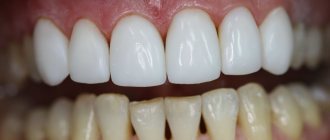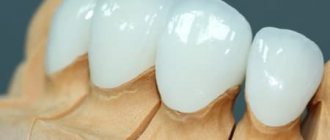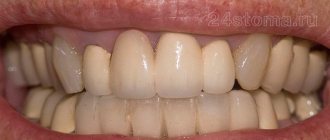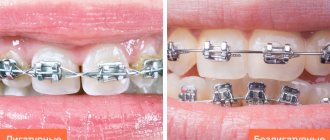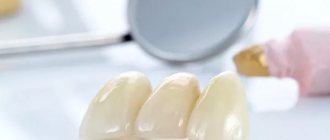A beautiful smile is a person’s calling card. The condition of your teeth affects not only your physical but also your mental health. It is also an indicator of success.
Previously, dentistry used dental crowns to restore even slightly damaged teeth. To do this, they had to sacrifice their natural teeth and subject them to severe grinding. Or remove the coronal part completely.
Now technologies make it possible to eliminate defects on the surface of the tooth, practically without processing it. For this, ultra-thin plates are used that are fixed on the outside of the tooth - veneers. The most popular of them are ceramic veneers, which have a high degree of aesthetics.
What it is?
Despite their ultra-thinness, the strength of the plates is comparable to the hardness of natural tooth enamel. The material allows you to repeat the shape of the tooth with maximum accuracy, hiding visible defects on its surface.
The demand for ceramic veneers is due to their practicality and full compatibility with the human body. The pads are non-toxic, do not cause allergic reactions, and do not require addiction. The translucent material is identical to natural tooth enamel. The shade scale allows you to select the color of the veneers that is similar to the shade of the patient’s teeth.
There are no problems with installing veneers: the plates are attached to the outside of the tooth using a dental compound.
pros
Fixing veneers is the fastest and most painless way to restore the aesthetics of teeth. Yes, the teeth are pre-treated. However, turning is no more than 0.5 mm.
The minimum duration of the procedure is associated not only with the immediate installation of veneers, but also with the number of visits to the dentist. If the patient does not require pre-treatment, the entire process will require no more than 3 visits to the doctor.
Important: you should not trust advertising that promises a Hollywood smile using veneers in one session. The plates are made in a dental laboratory based on previously taken impressions of the patient’s jaw. The work is complex, requiring extreme concentration and high professionalism. Therefore, it is impossible to create ceramic veneers in an hour or even in 2 hours.
Some methods of prosthetics require a long period of getting used to new teeth. Overlays do not fall into this category. After fixing microprostheses, unusual sensations may occur due to the appearance of a foreign structure in the oral cavity. But in just a day or two, the discomfort will disappear. Ceramic veneers do not affect the patient’s usual lifestyle, eating and diction.
Long service life is one of the main advantages of the plates. On average, veneers “live” for at least 15-20 years. When used correctly, of course. In addition, microprostheses can be installed in patients with high sensitivity - rejection and allergic reactions are excluded.
How are veneers installed?
“Planting” a veneer is not at all the same as installing a filling. From start to finish, this is a complex process, the correctness of which determines not only the aesthetics of the smile, but also how long the microprosthesis will last. Only by following clear regulations will the dentist be able to not only “glue” the onlay on, but to ensure that it practically merges with the natural tooth. Therefore, the patient will have to be patient and courageously go through all stages of dental intervention:
- Consultation.
In the absence of obvious contraindications for installing veneers, the dentist will still try to find a more gentle method of correcting imperfections: bleaching for darkened enamel, orthodontic treatment to eliminate gaps and malocclusion. - Grinding the enamel.
The doctor makes the preparation to a shallow depth - up to 0.5 mm, which is much less than when installing a crown. Thanks to modern anesthetics, this stage is completely painless. - Scanning.
Conventional impression taking is becoming less and less common in dental practice. Now intraoral scanners are coming to the aid of doctors, providing dental technicians with more accurate information about the configuration of the patient’s dentition. - Making veneers in a dental laboratory.
This stage usually lasts from 7 to 14 days. - Fixing the overlays.
When the veneers are ready, the patient comes back for an appointment. Here, using dental glue, the doctor reliably connects the ceramic plate and the patient’s natural tooth. It takes from 30 to 60 minutes to process 1 tooth.
In the interval between preparation and fixation of the finished onlays, the patient is fitted with temporary veneers made of composite materials. They can easily withstand everyday stress and maintain psychological comfort.
Veneers with up to 30% discount
Moscow
Disadvantages of the design
The main disadvantage of veneers is the price. For this reason, the procedure is not available to everyone. If we are talking about a minor flaw, then you can choose a more budget option - composite veneers. The material is applied directly to the tooth surface. And under the influence of the light flux, it gradually, layer by layer, hardens, forming a plate.
If the problem is related to darkening of the enamel, you can use a professional whitening procedure. The service is less expensive, but no less effective.
Another disadvantage of plates is the grinding of teeth. No matter what thin ceramic veneers are used, it will not be possible to simply remove the structure from the teeth. You will need to install a new onlay or crown.
In what cases are plates installed?
The main purpose of onlays is to eliminate aesthetic defects on the front teeth. It can be:
- Chips and cracks.
- Previously installed fillings that have changed color or cracked.
- Interdental gaps and tooth pigmentation that cannot be eliminated by professional cleaning.
- Pathological abrasion of enamel.
In addition, ceramic veneers help correct minor changes in the bite, crooked teeth, and a decrease in the volume of gum tissue.
Contraindications
Despite the versatility and practicality of the technique, there are limitations to the installation of veneers. For example, the use of plates is contraindicated in cases of bruxism, the presence of inflammatory processes, bone tissue pathology, and malocclusion.
Also, ceramic veneers are not used for the restoration of severely damaged teeth (more than 50%). In this case, the doctor installs crowns.
A refusal to carry out the procedure may be the presence of bad habits (biting nuts, nails, opening bottles with teeth, etc.). Or a high risk of maxillofacial injury. For example, extreme sports.
Gum disease and loss of chewing teeth will also require preliminary treatment before installing plates.
Indications and contraindications for installing veneers
Veneers are recommended:
- If there is a slight curvature of the teeth that fall within the visible area of the smile. Provided that there is no serious violation of occlusion (correct functional relationship of the jaws).
- Unsatisfactory enamel color. The color of enamel is naturally different for all people. Over time, changes in color often appear (spots, yellowing, etc.)
- The presence of minor teeth and diastemas (gaps between teeth).
- Thinning of the tooth during previous treatment by installing fillings.
- Unattractive teeth shape.
- Chips, cracks.
- Sensitivity to thermal and chemical influences that cannot be addressed through therapeutic treatment.
Contraindications for installation:
- Severe tooth wear. There are reasons for this, which are usually associated with a functional malocclusion.
- If the teeth on which veneers are planned to be installed are severely damaged (too small an area remains, which is not enough for reliable fixation of the veneer).
- If there are no chewing teeth. The absence of several chewing units significantly increases the load on other teeth.
- Extreme or traumatic sports with a high probability of leading to dental injury.
- The presence of bruxism (strong clenching of the jaws to the point of grinding during night sleep).
- The presence of carious diseases that are planned to be treated with veneers. Before planning prosthetics, it is necessary to treat carious processes.
Production technology
Ceramic veneers are usually made using three techniques:
- Applying the composition to a plaster model followed by heat treatment. The dental technician evenly distributes the composition over the surface of a special material that holds the paste during firing. The technique is inexpensive and allows reducing shrinkage of the structure.
- Casting. In this case, a model of future ceramic veneers is first created using wax. Then it is fixed in a refractory mass and installed in the sprue. Processing is carried out under high temperature. At the final stage, the dental technician paints the plates in a color that matches the patient’s tooth enamel.
- Pressing (Emax). More modern technology that reduces the porosity of the material. This ensures maximum structural strength. As a result, pressed plates have a longer service life. After processing, ceramic veneers are coated with a special compound that adds shine to the overlays.
Recently, the digital method of making veneers using a milling cutter has become popular. The model for the plates is obtained using a non-contact scan of the patient's oral cavity. A computer program calculates the structure. The sample is then sent for milling. The advantages of the method are obvious: the automated process eliminates possible inaccuracies and errors in the production of microprostheses.
Several popular questions that confuse patients from the “Is it true?...” series
1. There will be food getting and getting stuck between the veneer and the tooth.
No. With high-quality treatment, the veneer adheres to the entire surface of the tooth, without any gaps for food to enter.
2. Veneers can harm human health.
No. They are made from high-quality materials (both composite and ceramic), which cannot affect health in any way, does not provoke allergic reactions, and is absolutely biocompatible with the body.
3. Veneers can be installed on all teeth, including chewing teeth.
No. Veneers are made and installed only in the visible smile area. Installing them on the external surfaces of chewing teeth is not only impractical, but also fundamentally incorrect, since there is a completely different force of chewing load there.
4. Veneers are painful.
No. Again, if we are talking about appropriately qualified specialists. Starting from tooth preparation and continuing with further installation steps, everything happens with the use of high-quality anesthetics. With proper, qualified installation, there is no pressure on the gums, there is no need to get used to them, everything happens naturally.
5. Teeth look unnatural.
No. A competent specialist will always discuss the color of your future teeth with you and, for his part, will always give a recommendation and comment on whether it will look great or is worth another thought.
Diagnostics
The fixation of ceramic plates is carried out in three stages: preparation for the installation of veneers, production of the structure and fixation on the teeth.
Correctly performed diagnostics determines how long the orthopedic structure will serve the patient. In addition to the condition of the teeth, it is important to identify possible hidden pathologies in the bone and soft tissues of the jaw. And also carefully study the anatomical structure of the teeth being restored.
At EspaDent clinics, specialists conduct radiographic examinations for more accurate diagnosis. In complex cases, a modern 3D tomograph is used, which creates three-dimensional, layer-by-layer images of both jaws. During a consultation in our clinics, the doctor will offer the best options for microprostheses and immediately indicate the cost of the procedure.
How does the installation work?
If the patient does not require preliminary treatment, the next step is professional oral hygiene. The dentist removes hard and soft plaque from the teeth and disinfects the oral cavity. Before treating the teeth, the specialist selects the color of future ceramic veneers according to the Vita shade scale. Grinding of teeth is carried out in a gentle manner, without pain. If necessary, safe local anesthesia is used.
Next, the doctor proceeds to taking impressions of the teeth. According to the chosen method, first a model of the plates is made, and then the final microprosthesis. On average, the production of ceramic veneers takes 1-2 weeks, depending on the complexity of the design.
While the patient waits for new veneers, temporary plastic or composite veneers are fixed to the treated teeth. Onlays protect your natural teeth from bacteria. They also provide chewing function before the installation of microprostheses.
After the plates are ready, the doctor fixes them on the teeth one by one. Each dental unit requires approximately 30-60 minutes.
Is it possible to replace an old veneer with a new one?
There is no exact service life and replacement time for old linings. The shade of the existing plates simply changes or their surface becomes leaky, and caries begins under the composite (if ceramics are installed, the development of caries is practically excluded). The clinic removes the old structure, the cost of the procedure is 3900 rubles per tooth. And a replacement is immediately selected for them.
There are frequent requests from patients who once had composite veneers installed, but today they would like to change them to ceramic ones, including those made using CEREC technology. Emax veneers are of ideal quality and speed of production. A new Cerec veneer can be obtained in 1.5 hours, and such veneers do not require an adjustment period.
How to create a Cerec overlay:
- The enamel is processed and the tooth is scanned. No cast needed.
- A three-dimensional model of the overlay is created taking into account the physical data.
- An automatic machine turns a prosthesis from an array of pressed ceramics.
- The veneer should be tried on and fixed.
If questions arise or the shade does not match, a corrected copy will be received within a few minutes. But such cases are rare. Veneers are ideally fixed even on uneven teeth - if the installation work is carried out by an experienced specialist. The perfect fit of the plates prevents bacteria and food particles from getting under the lining.
Classification of structures
Microprostheses are distinguished by the type of material used in their manufacture. Ceramic veneers, without impurities, are considered traditional. For example, porcelain or pressed ceramics. The advantage of these plates is their impeccable aesthetics. The veneers look natural and neat on the teeth. But ceramics are far from the most durable material. It is not able to withstand significant chewing load.
To increase strength, dentistry has developed zirconium dioxide veneers. In this case, the microprosthesis consists of two layers: a zirconium base and a ceramic lining. Dental crowns are made using the same principle. Important: these plates are metal-free. It is not zirconium (metal) that is used here, but zircon, a natural white mineral. The stone has increased hardness, which allows it to be used to restore lateral teeth. However, the aesthetics of zirconium plates are far from perfect, so after production, an additional layer of ceramic is applied to the veneers. The result is durable ceramic veneers with enamel identical to natural teeth.
The third group includes lumineers - ultra-thin plates. The thickness of the onlays does not exceed 0.2-0.3 mm, which minimizes the process of grinding the teeth. The use of lumineers allows you to hide flaws in the dentition, while preserving the enamel of your natural teeth. The minimum thickness does not affect the functionality of microprostheses in any way. The plates can withstand full chewing load, without chips or cracks. However, there is also a downside: the manufacture and installation of ultra-thin veneers is similar in complexity to jewelry work. High qualifications of both the dental technician and the dentist are required. Which leads to an increase in the cost of the procedure. The cost of making lumineers can be 3-4 times higher than traditional porcelain veneers.
Free consultation on the cost of treatment in our dentistry
Leave a request and the clinic administrator will contact you within 15 minutes!
Zirconium veneers
We have already talked about zirconium dioxide veneers above; they are worth choosing if you are interested not only in the aesthetics of the result of dental restoration, but also in its maximum reliability. The zirconium frame, on which a layer of ceramic is applied, makes the finished structures capable of withstanding various types of loads.
Lumineers
An innovation in aesthetic dentistry is lumineers, which can be considered a separate type of ceramic veneers, since the material used for their production is the same dental porcelain.
The difference will be in thickness; lumineers are an ultra-thin type of ceramic plates and therefore their installation will not require preliminary grinding of tooth enamel. Lumineers are not fixed with cement, but with a special original composition that ensures fastening strength and, in addition, contains fluoride, which has a positive effect on dental units and strengthens them.
The minimum thickness of lumineers should not alarm the patient: this type of ceramic veneers is produced using a special technology that ensures their strength and long service life - up to 20 years! Not only will the ceramic plate not change color from contact with coloring foods and drinks, it can flawlessly withstand mechanical stress and contact with aggressive substances.
Lumineers are often chosen for restoration by famous people and stars of the world of music and cinema, which is why their second name is Hollywood ceramic veneers. The price of ceramic veneers in this option will be as high as possible, but fully justified by their impeccable performance and aesthetic characteristics.
We hope that our short comparative analysis of the types of veneers will help you make the right choice, and you can always get more detailed and professional advice on ceramic veneers and their installation at our dental clinic in Moscow - Vanstom! Come to our specialists for a personal appointment, we are located in the center of Moscow, next to the Baumanskaya metro station.
Budget analogue
There is an easier and faster way to restore teeth. Composite veneers help with this - a polymer in the form of a paste that is applied directly to the surface of the tooth. The composition is mixed in the dentist's office, which allows you to complete the procedure in one visit. Of course, if there is no need for preliminary treatment of teeth and soft tissues.
The composite has good aesthetics and does not require significant grinding of natural teeth. Hardening is carried out layer by layer, under the influence of light flux. This provides the necessary strength to microprostheses. The technique is suitable for restoring lateral teeth.
Disadvantages of polymer restoration:
- Shorter service life compared to ceramic veneers - no more than 5-6 years.
- Instability to pigmentation. The material changes color over time and absorbs coloring components.
- Imperfect match to the shade of natural enamel.
Manufacturers
To protect yourself from low-quality prosthetics, check with the clinic about what materials are used in the procedure. Mainly large companies specialize in the production of ceramic veneers. There aren't many of them.
The most famous company Nobel Biocare is a leader in implantology and prosthetics. It was this manufacturer that developed the popular protocols for implantation procedures All-on-4, All-on-6, Trefoil, etc. In the case of installing veneers, the company specializes in the production of zirconium plates.
The list includes German and Japanese companies that produce their products under the brands Katana, Prettau and BruxZir Anterior. The leader in the production of pressed and solid ceramics is Ivoclar Vivadent, which specializes in Emax technology.
Many years of experience, modern materials and strict quality control allow these companies to occupy a strong position in the dental materials market.
The difference between composite veneers and ceramic
There is no point in trying to choose the perfect option. Each technique has its own advantages and disadvantages. For example, porcelain plates are most effective for restoring the front row of teeth, in the smile area.
On the contrary, the use of composite veneers is indicated for the restoration of chewing teeth. Plus, it's an inexpensive way to restore your beautiful smile. And, as a result, self-confidence. It is advisable to use a composite polymer for point adjustments - 1-2 teeth. While ceramics are effective for the restoration of the entire dentition.
The advantages of ceramic veneers include the quality of adhesion to the tooth surface. The onlays cover not only the front, but also the lateral parts of the dental unit. Due to this, the structure adheres better to the teeth. Ceramics does not lose its original appearance throughout its entire service life. While composite veneers fade, darken, and lose their visual appeal.
There are differences in the installation and maintenance of orthopedic structures. Polymer plates are fixed to the teeth immediately in one session. For porcelain or zirconium, it takes 1-2 weeks to produce the plates. For minor damage, the photopolymer can be corrected by sanding. But if there are chips or cracks, ceramic veneers will have to be replaced.
To maintain the aesthetics of composite plates, you will have to give up bad habits (smoking). And also do not use pigmenting products. In this case, there are no restrictions for ceramics, because the material is stain resistant.
What other types are there?
The predecessors of ceramic veneers are composite onlays, which are still installed in some clinics today, mainly on chewing teeth. The advantage of this type of microprosthetics is its relative cheapness and the ability to carry out the procedure in just 1 visit to the doctor. This is possible because composite veneers are made from filling material using the direct method, that is, directly in the patient’s mouth.
Unfortunately, composite linings have a lot of disadvantages. Firstly, they wear out quickly, and with the most careful care they last no more than 5 years. Secondly, even the most expensive composite at its core still remains plastic, which is always noticeable in the mouth, and over time it also loses its shine, delaminates, and darkens.
Today, ceramic veneers are the most reliable way to restore the attractiveness of your smile. At the same time, even from a close distance, no one will guess that microprosthetics have been performed.
Price issue
The cost of ceramic veneers is influenced by the material, installation method, and complexity of the procedure. As well as the qualifications of the doctor and the reputation of the clinic. On average, prices for pressed ceramics start at 23 thousand rubles. Zirconium ones will cost 35 thousand and more, composite ones - from 10 thousand rubles.
If after diagnosis the patient needs dental treatment, the final cost will be higher.
At EspaDent clinics, the patient learns the final amount immediately after the initial diagnosis. No surcharges or hidden fees. For expensive procedures, our patients have the option of interest-free installments. Diagnostics and initial examination in all EspaDent clinics are free of charge.
Care instructions
After dental restoration, you want microprostheses to last as long as possible. This is a completely doable task if you follow the recommendations for caring for ceramic veneers. There are no complicated regulations. The rules are the same as for preserving natural enamel:
- Daily oral hygiene. Use a medium-hard toothbrush and a toothpaste without abrasive particles (not whitening).
- To clean the interdental spaces, it is recommended to use dental floss and rinse your mouth after eating.
- Do not eat too hard foods. Avoid sudden changes in temperature (very hot and cold food).
It is also important to visit the dentist 1-2 times a year for a preventive examination and professional oral hygiene.
In the first days after installation of veneers, unusual sensations may occur due to the appearance of foreign material in the mouth. Especially if the teeth have changed length after prosthetics. But the discomfort will disappear after 1-2 days.
Lifetime
Depending on the type of structure, the service life is determined. For example, plates that overlap the cutting edge, according to research results, turned out to be a more reliable product.
Overlays made of pressed ceramics are considered to be the most durable. The material is able to retain its original properties for up to 12-15 years, without deteriorating in appearance. Here, it is not the ceramic veneer that wears out to a greater extent, but the cement on which it is attached.
Zirconium plates are not far behind in reliability. Their lifespan is at least 10-15 years. The most expensive lumineers, with proper care, will delight their owner for up to 20 years.
Wear resistance is directly affected by the quality of production and installation of the plates. Porcelain veneers that do not fit tightly to the surface of the tooth can crack or even fall out. And bacteria will accumulate in the space between the tooth and the plate, which will lead to the appearance of carious cavities. Therefore, it is important to carefully choose a clinic and a doctor for prosthetics and dental treatment procedures.
Is it possible to fix already installed veneers?
Alas, after manufacturing and installation, it is no longer possible to correct the color, size, or shape of a ceramic veneer. The same goes for repairing a chip that has appeared with a composite material. It's pointless and not aesthetically pleasing. Therefore, the most important thing is to immediately choose a clinic that provides a long guarantee on materials and the prosthetic service itself. And trust the doctor whose professionalism does not cause you the slightest doubt.
Author: Oleg Kovalenko Chief physician. Doctor - orthopedic dentist, implant surgeon. Candidate of Medical Sciences. Work experience more than 13 years. The information is for reference only. Before treatment, consultation with a doctor is necessary.
Which is better, plates or crowns?
There is a myth that installing an artificial crown is more reliable than veneers. This is wrong. If the tooth is healthy, but has a slight aesthetic flaw, it is wiser to use plates. Overlays help to cope with small defects. Provided that most of the tooth is intact. In this case, not only the aesthetics of the tooth is restored, but also its functionality. If you use a crown instead of a plate, the tooth will have to be ground down much more. This can lead to premature destruction of hard tissue.
A crown is applicable in cases where the tooth is damaged by more than half. Then, in order to ensure chewing function, it will be necessary to restore the missing hard tissues of the tooth. The veneer is attached only to the outside of the tooth, so it will not cope with this task.
In other words, for the restoration of existing teeth, ceramic veneers are the best solution. And to restore a dental unit in a row - a crown.
TERMS AND ACCEPTED ABBREVIATIONS
Personal data (PD)
– any information relating to a directly or indirectly identified or identifiable individual (subject of personal data);
Processing of personal data
– any action (operation) or set of actions (operations) performed using automation tools or without the use of such means with personal data, including collection, recording, systematization, accumulation, storage, clarification (updating, changing), extraction, use, transfer (distribution, provision, access), depersonalization, blocking, deletion, destruction of personal data;
Operator or organization
– a state body, municipal body, legal entity or individual, independently or jointly with other persons organizing and (or) carrying out the processing of personal data, as well as determining the purposes of processing personal data, the composition of personal data to be processed, actions (operations) performed with personal data;
Distribution of personal data –
actions aimed at disclosing personal data to an indefinite number of persons;
Providing personal data
– actions aimed at disclosing personal data to a certain person or a certain circle of persons;
Blocking personal data
– temporary cessation of processing of personal data (except for cases where processing is necessary to clarify personal data);
Destruction of personal data
– actions as a result of which it becomes impossible to restore the content of personal data in the personal data information system and (or) as a result of which material media of personal data are destroyed;
Depersonalization of personal data
– actions as a result of which it becomes impossible to determine the ownership of personal data by a specific subject of personal data without the use of additional information;
Automated processing of personal data
– processing of personal data using computer technology;
Personal Data Information System (PDIS)
– the totality of personal data contained in databases and the information technologies and technical means that ensure their processing;
Patient
– an individual who is receiving medical care or who has applied for medical care, regardless of whether he has a disease or his condition;
Medical activities
– professional activities in providing medical care, conducting medical examinations, medical examinations and medical examinations, sanitary and anti-epidemic (preventive) measures.
Attending doctor
– a doctor who is entrusted with the functions of organizing and directly providing medical care to a patient during the period of observation and treatment.
